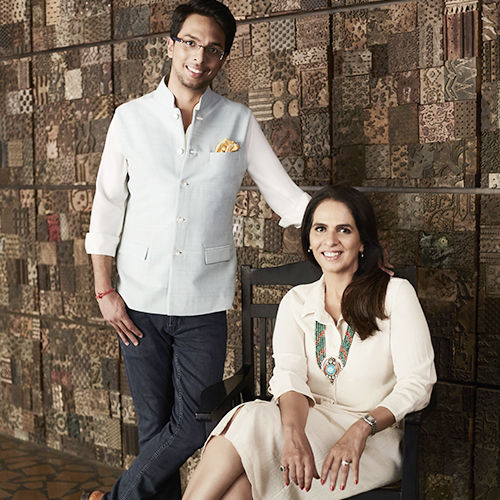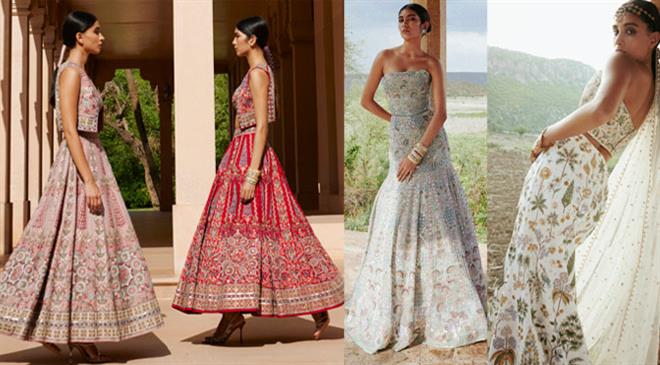
Anita Dongre & Yash Dongre
Founder & President of Business Operations
House of Anita Dongre Limited
It is an exciting time to be a designer in India
Founded in 1995, the House of Anita Dongre is a top Indian fashion house, boasting over 2,500 associates. Notably, it was the first Indian fashion firm invested in by a leading private equity firm, General Atlantic. The brand offers luxurious, versatile designs and promotes Indian craftsmanship, aiming for a sustainable future. In an interview with Fibre2Fashion, Founder Anita Dongre and her son Yash Dongre talk about the brand’s journey and the importance of incorporating Indian traditional crafts in their designs.
Fibre2Fashion: Can you tell us about your journey in the fashion industry and how it began?
Anita Dongre & Yash Dongre:
Anita Dongre (AD): It started with very humble beginnings. For the entire journey, I will have to write a book, for which you will have to wait until next year. I wanted to get into fashion since I was 15. I studied design and initially started out with two sewing machines in my balcony, and today we are The House of Anita Dongre, that employs over 2,500 people directly and thousands of artisans indirectly. It has been an amazing journey, and we still have a long way to go.
F2F: What are your usual sources of inspiration for your designs?
AD&YD:
AD: My main source of inspiration has always been India, particularly Rajasthan, and I think Gujarat; Gujarat is an amazing state. Rajasthan and Gujarat have similar crafts yet are distinct from each other. Both states have a rich history of design, colours, and textile traditions.
F2F: How would you describe the evolution of your design aesthetics over the years and what factors have influenced this evolution?
AD&YD:
AD: I think one thing that has stayed constant in all my designs is that they have always been very simple, comfortable, and wearable. This has been my ethos when I started out as a young designer straight from college. Starting from my graduation design, my work has always been about comfort, wearability, and empowering the woman to feel better about herself. I believe that when you wear great designs, you feel good about yourself. That has always been my goal right from the beginning of my career. Then of course, in fashion, styles come and go, but the ethos of what I want and why I work in fashion has always remained the same, and that is what excites me even today.
F2F: What are your thoughts on sustainable and conscious fashion?
AD&YD:
AD: Sustainable fashion is a much-abused term today, but I think, every designer in the present times must start thinking about conscious, mindful fashion seriously. Today, climate change is at our doorstep, and fashion plays the role of a huge contributor in this. So all of us have to be very mindful of whatever we do in fashion. For me, this means that when I create a design, it should offer social and sustainable benefits. This could be a design that could require a craft which empowers artisans. Or maybe, simply choosing to avoid leather and opting for a vegan, cruelty-free alternative.
F2F: What changes have you noticed in the Indian fashion industry so far?
AD&YD:
AD: There have been huge changes in the Indian fashion industry. It has finally come of age. The National Institute of Fashion Technology (NIFT) came into being around 30 years ago, and since then, so many graduates from NIFT and other design institutes have come in. So, now you actually have a huge number of designers and a lot of them are doing amazing work. Customers are understanding designers’ aesthetics as well as their own sense of style. It is an exciting time to be a designer in India.
F2F: Your brand has become synonymous with Indian handcrafted textiles and traditional techniques. How do you collaborate with artisans and craftsmen to preserve these age-old skills?
AD&YD:
AD: I am passionate about ensuring that Indian crafts are preserved. I think the only way that can be done is with me working with and providing sustained employment to artisans. So season after season, we try our best to protect the sacredness of Indian crafts. Reinventing every season is very exciting.
F2F: When expanding into new markets like New York and Dubai, what factors do you consider and how do you balance your brand’s Indian identity with local preferences?
AD&YD:
AD: The brand as well as design language stays the same. It helps to understand what customers in that region want. Our design ethos has stayed the same as it is the Anita Dongre world that we take everywhere with us. It’s all about getting closer to our consumers who want to enjoy the experience.
F2F: What is the importance of incorporating crafts into bridal designs and how does it preserve the essence of traditional craftsmanship?
AD&YD:
AD: The bridal line started about 10-11 years ago. I wanted to design bridal wear that was comfortable. The Indian bride today has no qualms dancing at her wedding, even more than her girlfriends, so for me, comfort for her was most important. We were the first design house to revive the art of Gottipati, which is from Rajasthan. We created beautiful light lehengas and were the first design house to create lehengas with pockets. We started working with a lot of crafts. After gota work, the latest addition is the art of hand-painting by artists in Rajasthan. We have created lehengas with them every season. We also do Bandini bridal lehengas. I love incorporating crafts into my bridal designs because workmanship that existed 20-30 years ago is non-existent today. So, it is only by using crafts for couture luxury weddings that the essence of that work can be preserved. For instance, mothers will pass down gorgeously hand-painted lehengas to their daughters because you would not be able to find that quality of craftsmanship some 30 years down the line. Even with the work I do with the SEWA artisans in Gujarat, so many of the stitches today are not being practiced by the next generation because they’re too difficult. One way to save such original craftsmanship and artistry is by using it in couture. Those who buy such bridal couture support Indian crafts.
F2F: Please suggest some ethnic wardrobe essentials and accessories as well as tips for women to stay stylish.
AD&YD:
AD: I think the saree is simply timeless and every Indian woman should own a saree from every craft region of India. As for accessories, you have beautiful Indian jewellery. So, Indian jewellery and sarees are all that a woman really needs to start her Indian wear wardrobe. I think getting a vegan leather Anita Dongre bag will help add a special touch to her look.
F2F: What advice do you have for young designers to thrive in an ever-evolving fashion industry?
AD&YD:
F2F: Looking ahead, what are your aspirations for the Anita Dongre brand? Are there any upcoming projects or initiatives that you are particularly excited about?
AD&YD:
AD: As always, I am quite excited about the new collection I am working on. Like many of my previous collections, this one too is inspired by nature.

Anurag Batra
Fanny Vermandel
Rahul Mehta
Bill D’Arienzo
Abhay Gupta
Gabi Seligsohn
Arun Sirdeshmukh
Rahul Mehta
Aseem Prakash
Pradip Mehta


20230103183907.png)







_8.JPG)


